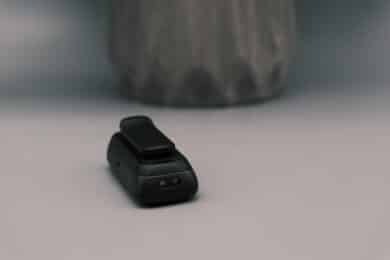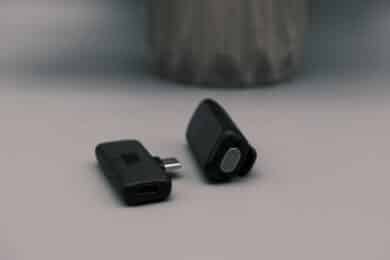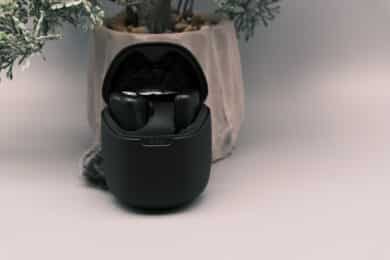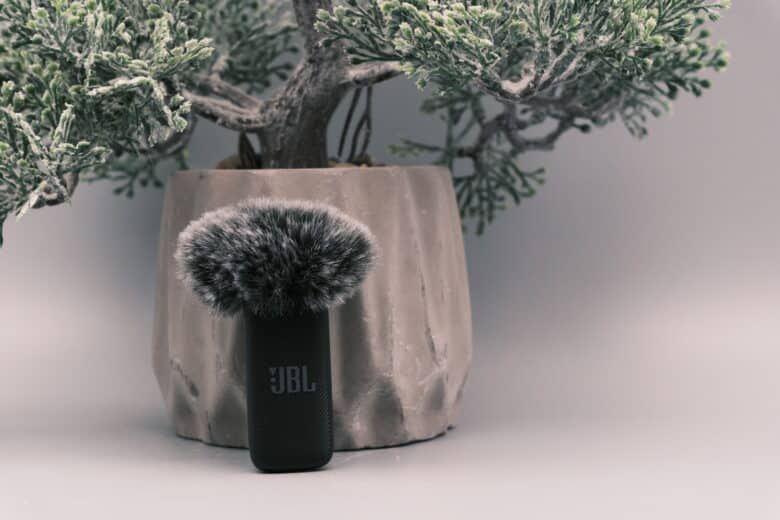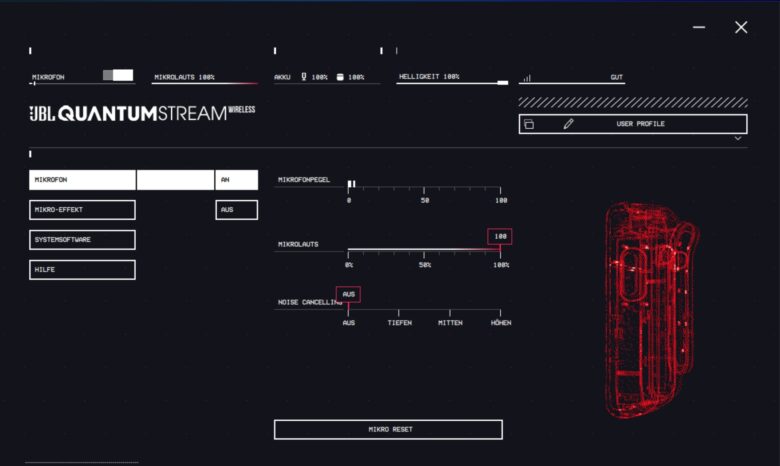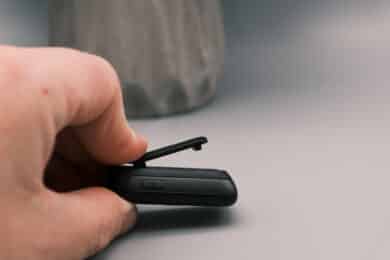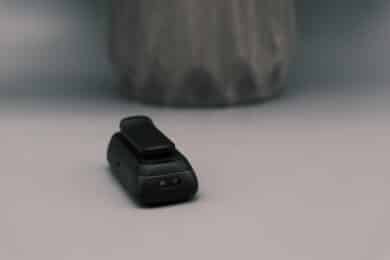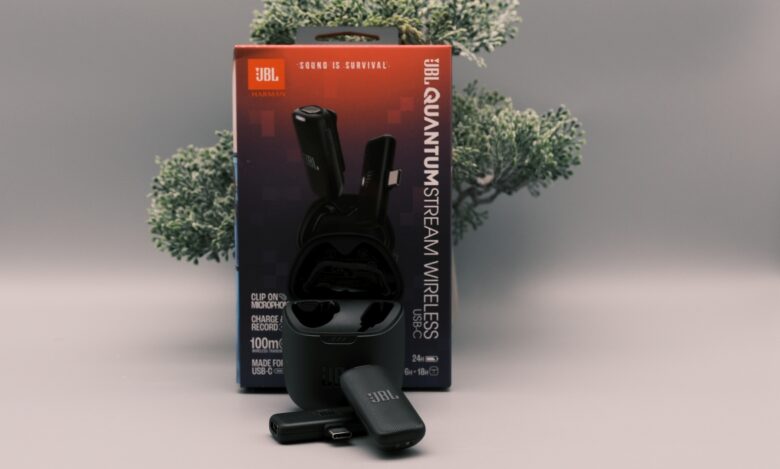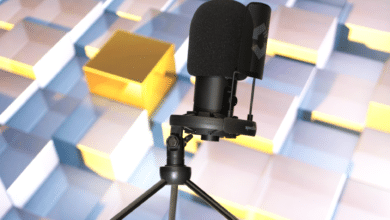
Audio specialist JBL recently launched a whole range of microphones, including the impressive USB mic Quantum Stream Studio, which scored particularly well in our test thanks to its versatility. With the JBL Quantum Stream Wireless, there is now a wireless solution that is primarily aimed at mobile content creators and is designed to compete with the Razer Seiren BT, DJI Mic 2 and the like. Our test clarifies whether this works.
Technical data
| Product: | Quantum Stream Wireless |
| Connection: | USB Type-C |
| Microphone diaphragm: | Unknown |
| Frequency response: | 20 Hz – 20,000 Hz |
| Sampling rate: | 48 kHz / 16 bit |
| Polar pattern: | Cardioid |
| dimensions | 47 mm x 22 mm |
| Weight: | 11 grams |
| Connectors: | USB-C |
| Special features: | None |
| Price: | € 89.90 * |
JBL Quantum Stream Wireless Test: Design and workmanship
- compact dimensions
- Lightweight and mobile
- good workmanship; but susceptible to fingerprints
The design of the JBL Quantum Stream Wireless is similar to many other wireless microphones for mobile use. The microphone, receiver and charging case are finished in a glossy black that is quite susceptible to fingerprints.
The microphone itself is pleasantly compact. It is around 47 mm long, 22 mm wide and (with clip for clothing) around 18 mm deep. With a weight of 11 grams, it is hardly noticeable when worn.
The T-shaped USB-C receiver has an additional USB-C input on the side so that the smartphone can be charged while streaming or recording, for example. Very practical. The duo is housed in an equally handy charging case, which is charged via USB-C and has a three-stage charging LED on the front.
But back to the microphone. It has a button on the left-hand side that can be used to quickly mute it. If you press and hold the button, you can also trigger wireless pairing again.
The actual microphone, which records the voice, is located on the top. The windscreen included in the scope of delivery can also be easily attached and removed here. However, the microphone no longer fits into the charging case with the windscreen – unfortunately, there is also no way to stow the puschel away. So caution is advised.
Setup, software and practice
Setting up the JBL Quantum Stream Wireless is very simple. Simply connect the wireless receiver, initiate pairing and the microphone is reliably recognized.
It is entirely up to you whether you want to use the microphone on a smartphone (or tablet) or on a PC or notebook. The main thing is that a free USB-C port is available. This makes the microphone suitable for both Android devices and iPhone models from version 15 and newer.
However, if you own an older iPhone with a Lightning connector, you can also find a variant with a suitable connector. However, you will then have to do without connectivity on the PC.
As the connection option is limited to USB-C and cannot be used without the corresponding receiver, connectivity and usage options are severely limited.
A 3.5 mm jack connection would open up many more possibilities. Unfortunately, the microphone was also not recognized on my Fujifilm DSLM camera, which has USB-C. So you are really limited to smartphone and notebook/PC.
Software and app connection
Of course, the software also depends on where you use the JBL Quantum Stream Wireless. The QuantumEngine software is used on the PC and notebook, which is also used for the manufacturer’s dedicated USB microphones and headsets.
On the mobile device, on the other hand, you need the JBL Headphones app. The range of functions of both applications is completely identical, but the smartphone app offers the clearer, better layout.
But it doesn’t matter, because there isn’t that much to adjust here anyway. In addition to information about the battery status and a connection quality display, you have the option of adjusting the microphone amplification (i.e. the gain) between 0 and 100 percent.
You can also adjust the noise suppression (ENC) to low, medium or high and deactivate it completely. A microphone effect can also be set. There are three presets to choose from: Natural, Powerful and Bright.
Apart from the option to perform firmware updates, you can only adjust the LED brightness and the automatic switch-off of the microphone. This makes it clear that the JBL Quantum Stream Wireless is designed to be very beginner-friendly through and through. Even non-experts should have no problems finding their way around the options.
Battery life
- Six hours of battery life
- 24 hours in total in conjunction with charging case
- Fast charging function.
With a battery life of up to six hours for the microphone alone, the Quantum Stream Wireless is also equipped for longer recordings. The charging case provides power for three further full charges, i.e. an additional 18 hours.
In total, you can record for 24 hours with the combination of Mikoron and charging case. That’s enough for a long weekend of vlogging. There is also a quick-charging function, thanks to which 15 minutes in the charging case provide the microphone with energy for an additional hour of recording.
Sound quality of the JBL Quantum Stream Wireless
- 48 kHz at 16 bit
- three audio presets
- ENC with strong effects on sound
- Recordings from PC somewhat asynchronous
The JBL Quantum Stream Wireless records in 48 kHz and with a bit depth of 16 bits. This is of course absolutely sufficient for studio-compatible recordings. It covers a frequency response of 20 Hz to 20,000 Hz and achieves a sensitivity of -36 dBV/PA at 1 kHz.
In terms of sound, the handy wireless microphone cuts a good figure in the standard setting. Positioned correctly on clothing and with the correct gain settings, it allows clear recordings. Unfortunately, the mic doesn’t offer a lot of gain reserves: I had to set the control to 100 percent to achieve really good results.
My voice is recorded in a pleasantly dynamic and powerful way. This already applies to the natural audio preset. The powerful setting provides a fuller, livelier sound, only the bright preset did not suit me personally at all, as the voice lacks volume and dynamics here.
The Environmental Noise Cancellin (ENC for short) proves to be practical, at least on paper, as it is actually very good at suppressing not only monotonous noises, but also typing on the keyboard and the like.
However, ENC has an enormous impact on voice recording. You should therefore use it carefully and only use noise suppression in really loud environments, otherwise the audio quality will drop rapidly.
I also noticed that the picture and sound are slightly asynchronous when recording from a PC/notebook, which is probably due to the latency of the transmission. When recording from the smartphone, however, both tracks are absolutely synchronized. So here too, the smartphone is the better choice.
JBL Quantum Stream Wireless test: Conclusion
With the JBL Quantum Stream Wireless, the manufacturer has created a thoroughly convincing wireless microphone that scores particularly well when recording from or with a smartphone.
In terms of functionality, the microphone is undoubtedly aimed at amateurs and lacks some advanced functions compared to the significantly more expensive competition. DJI, Rode and the like, for example, offer higher audio quality, more connections and a greater wireless range – but also cost three to four times as much as their JBL counterparts.
The JBL also lacks a 3.5 mm jack connection and the option of using the microphone with dedicated cameras via USB-C. Due to the existing latency, use on a PC is also not really recommended. However, if you are looking for a convincing microphone to enhance the sound of your smartphone videos, the JBL Quantum Stream Wireless is a very good choice.
JBL Quantum Stream Wireless
Workmanship
Recording quality
Features
Value For Money
86/100
Beginner-friendly wireless microphone that is quick and easy to use and also scores highly in terms of sound and battery life. However, the range of functions may not be sufficient for professionals.



